Home / Allylic Bromination
Free Radical Reactions
Allylic Bromination
Last updated: April 10th, 2025 |
Allylic Bromination and Benzylic Bromination: What Is It, And How Does It Work?
In previous posts on radicals, we’ve seen how bromine can selectively react with tertiary C-H bonds (bond strength 93 kcal/mol) over secondary (96 kcal/mol) and primary (100 kcal/mol) C–H bonds.
If you recall that bond dissociation energies are a good guide for predicting radical stability, then you won’t be surprised to learn that “benzylic” and “allyllic” C–H bonds can also be brominated selectively. These C-H bonds are particularly weak because the radical formed through the homolytic breaking of C-H is stabilized by resonance.
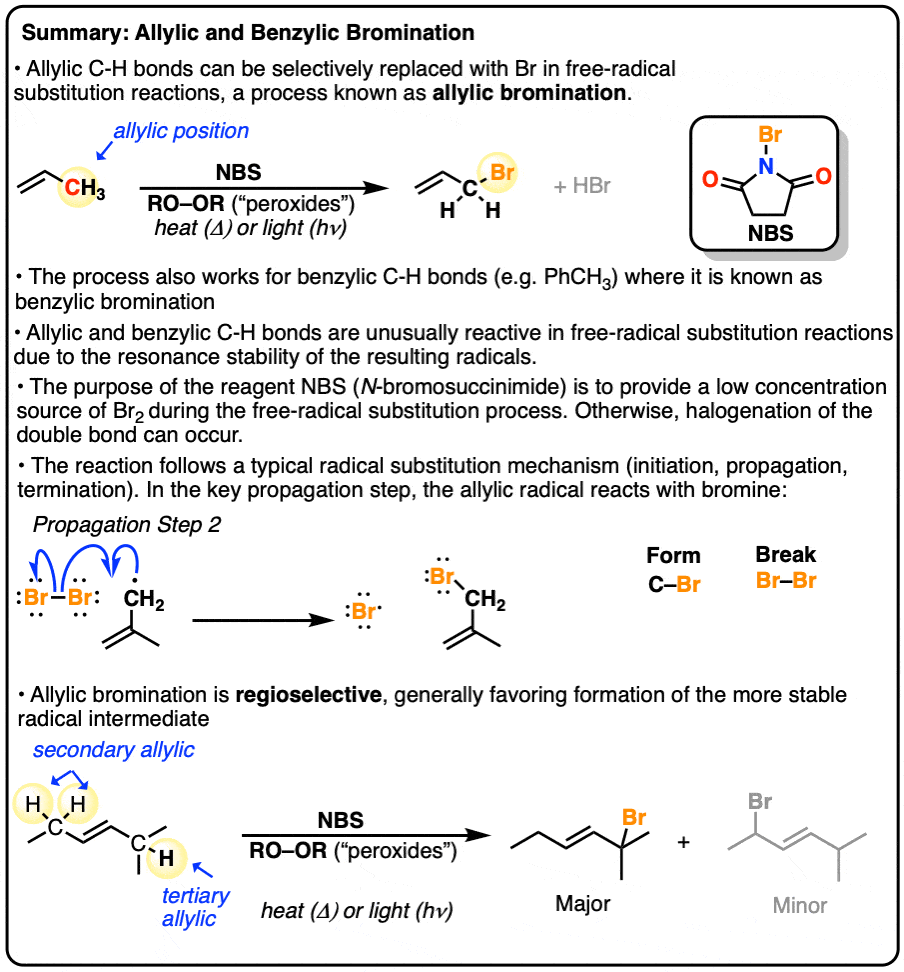
Table of Contents
- Allylic and Benzylic Bromination: Examples
- Free Radicals Are Stabilized By Resonance
- The Mechanism of Benzylic Bromination With Br2 and Light/Heat
- Br2 Is Not An Appropriate Reagent For Allylic Bromination Since It Forms Vicinal Dibromides
- Using N-Bromo Succinimide (NBS) Ensures A Low Concentration Of Br2
- Notes
- Quiz Yourself!
- (Advanced) References and Further Reading
1. Allylic and Benzylic Bromination: Examples
So what is allylic and benzylic halogenation, anyway? Here’s an example of each.
Take toluene and treat with either Br2 in the presence of light, as per this procedure, or N-Bromosuccinimide (NBS) in the presence of a radical initiator + heat (or light) and one of the benzylic C–H bonds is replaced with C–Br.
(Note that the “benzylic” position is the carbon attached to the benzene ring; the C-H bonds of the benzene ring itself are the “phenyl” C-H bonds).
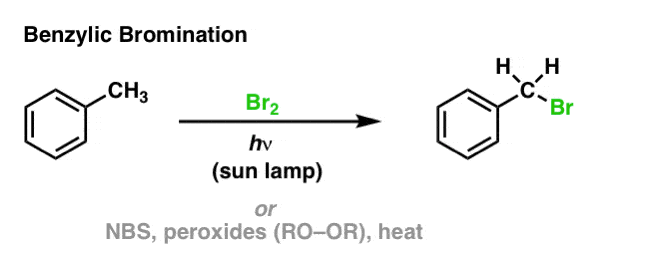
Here’s an example of the allylic bromination of propene, this time using NBS and peroxides (or heat)

We’ve spent a considerable amount of time discussing the stability of free radicals, particularly that primary radicals are particularly unstable.
So what’s different in this case? And what’s this “NBS” stuff?
2. Free Radicals Are Stabilized By Resonance
Recall that free radicals are stabilized by resonance, and bond dissociation energies (BDE’s) aka “bond strengths” measure homolytic bond cleavage.
So the methyl groups (above) aren’t ordinary methyl groups – the resulting radicals are greatly stabilized by resonance!
Therefore when we look at bond dissociation energies for benzylic and allylic C–H bonds it should not be surprising to find that these bond strengths are quite weak (89-90 kcal/mol for a primary allylic or benzylic radical) relative to tertiary C-H bonds (93 kcal/mol).
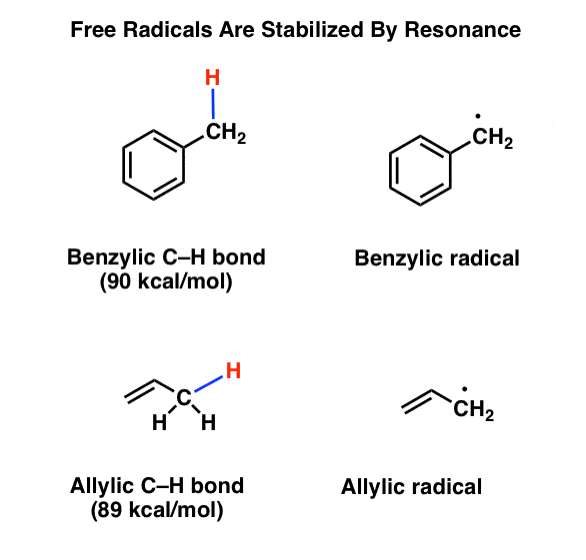
So how might allylic or benzylic bromination work?
3. The Mechanism of Benzylic Bromination With Br2 and Light/Heat
For benzylic bromination, hopefully imagining the mechanism will be straightforward: after initiation (by heat or light), bromine radical then breaks the C-H bond (forming the benzylic radical) [propagation step #1] and the benzylic radical attacks Br2 to re-generate bromine radical [propagation step #2]. These two steps repeat until the concentration of Br2 runs low, whereupon radical chain termination will occur.
[See Initiation, Propagation, Termination]
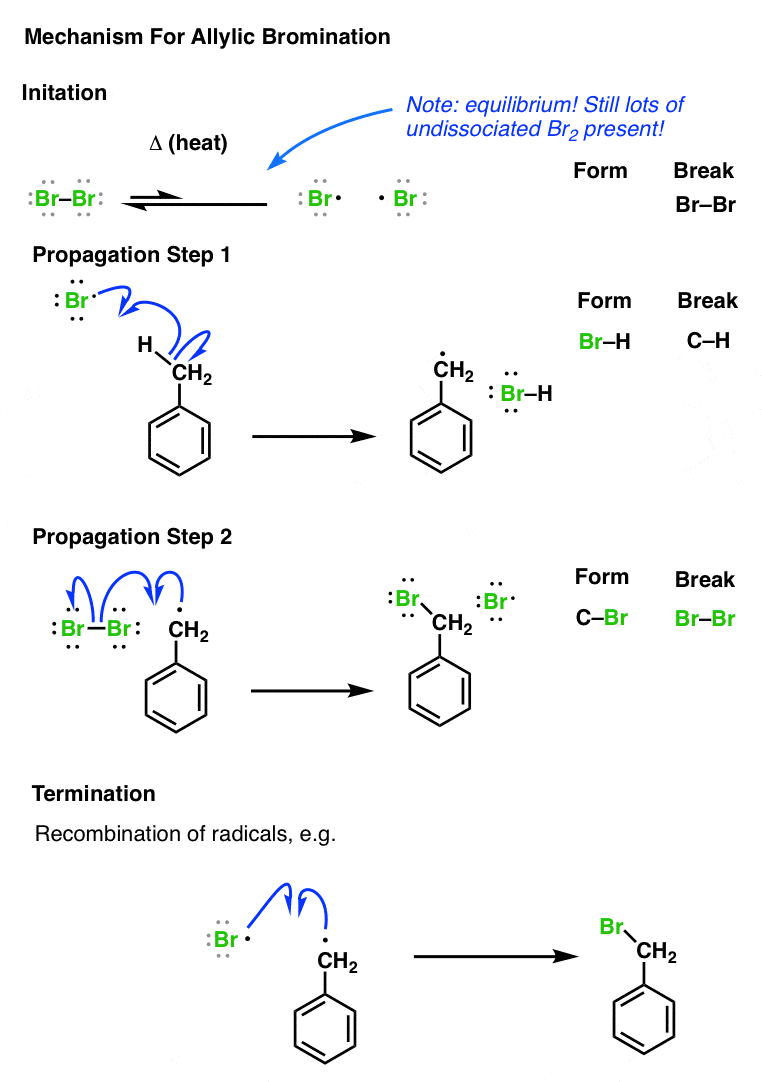
4. Br2 Is Not An Appropriate Reagent For Allylic Bromination Since It Forms Vicinal Dibromides
Let’s turn to allylic bromination. Do you see any reason why treating the molecule below with Br2 might lead to problems?

You might recall that alkenes react with Br2 to form vicinal dibromides, and that is in fact exactly what would occur if we were to just dump in 1 equivalent of Br2 with an alkene.
At issue here is the fact that we have 1 equivalent of Br2 swimming around, of which only a small proportion at any given time will exist as bromine radical [due to the initiation step].
How might we solve this problem and favour the radical substitution over the dibromination?
Imagine, if you will, we had a very low concentration of Br2. If the concentration of Br2 is kept low, not only will the rate of dibromination be lower, the relative concentration of bromine radical relative to Br2 will increase. Therefore, the rate of C-H abstraction relative to dibromination will increase, which will allow our allylic bromination product to be formed in a higher yield. [Note 1]
Of course, this creates a new question: how do we generate a low, constant concentration of Br2?
5. Using N-Bromo Succinimide (NBS) Ensures A Low Concentration Of Br2
As it turns out, there’s a way. If the bromonium ion source N-bromosuccinimide (NBS) is present with a trace amount of acid (HBr), HBr will react with NBS to give succinimide and Br2.[Note 2]
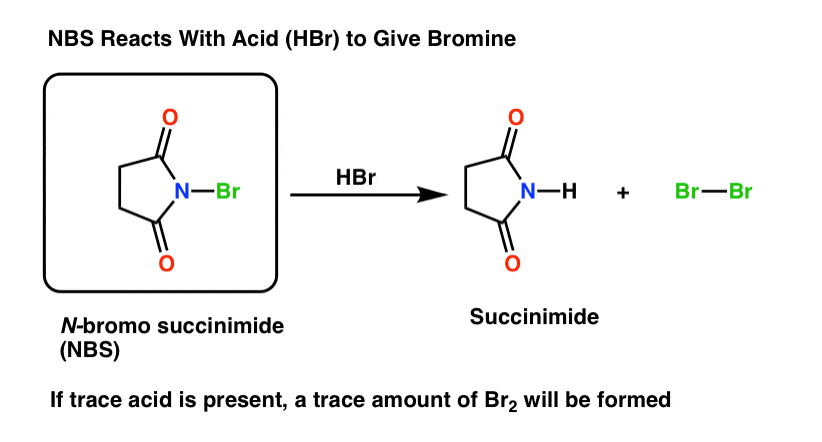
Since one equivalent of HBr generates one equivalent of Br2, Br2 will be generated only after the completion of Propagation Step #1.[Note 3].This keeps the concentration of Br2 low and allows the free-radical reaction to out-compete the alkene addition reaction.
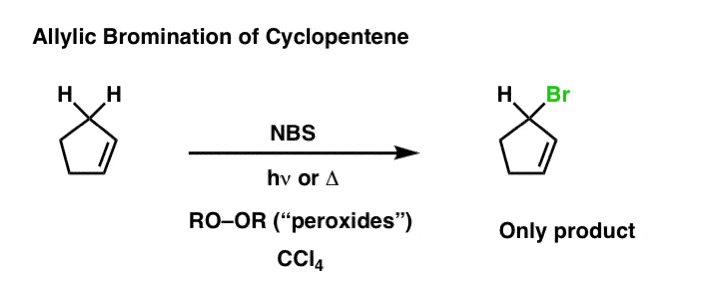
In all other respects the allylic bromination reaction is identical to the benzylic bromination reaction mechanism shown above. However in *some* situations there is an extra twist of allylic rearrangement, which we will briefly discuss in the next post.
Next Post: Allylic Rearrangement
Notes
Related Articles
- Selectivity in Free Radical Reactions: Bromination vs. Chlorination
- Free Radical Initiation: Why Is “Light” Or “Heat” Required?
- 3 Factors That Stabilize Free Radicals
- Bond Dissociation Energies = Homolytic Cleavage
- In Summary: Free Radicals
- Allylic Bromination
- Elimination Reactions (2): The Zaitsev Rule
- Alkene Stability
- Free Radicals Practice Quizzes (MOC Membership required)
Note 1. If this explanation sounds somewhat unsatisfactory, you’re on to something. After all, doesn’t this decrease the concentration of Br• as well? One additional complication is that theoretical studies show strong evidence for a termolecular rate determining step in formation of the bromonium ion (that is, involvement by the alkene and two molecules of Br2). Decreasing the concentration of Br2 would therefore vastly decrease the rate of bromonium ion formation (and thus dibromination) relative to free radical halogenation.
Note 2. As it happens, NBS which has been left out for awhile will usually be contaminated with trace HBr (as well as Br2, which gives it a yellow or orange colour). For this reason if doing a radical reaction with NBS it’s common to avoid recrystallizing it before use, as it will remove the trace acid that jump starts the reaction in the first place.
Note 3. As long as the initial concentration of HBr is low (i.e. it is used as a catalyst)
Quiz Yourself!

Become a MOC member to see the clickable quiz with answers on the back.

Become a MOC member to see the clickable quiz with answers on the back.

Become a MOC member to see the clickable quiz with answers on the back.

Become a MOC member to see the clickable quiz with answers on the back.
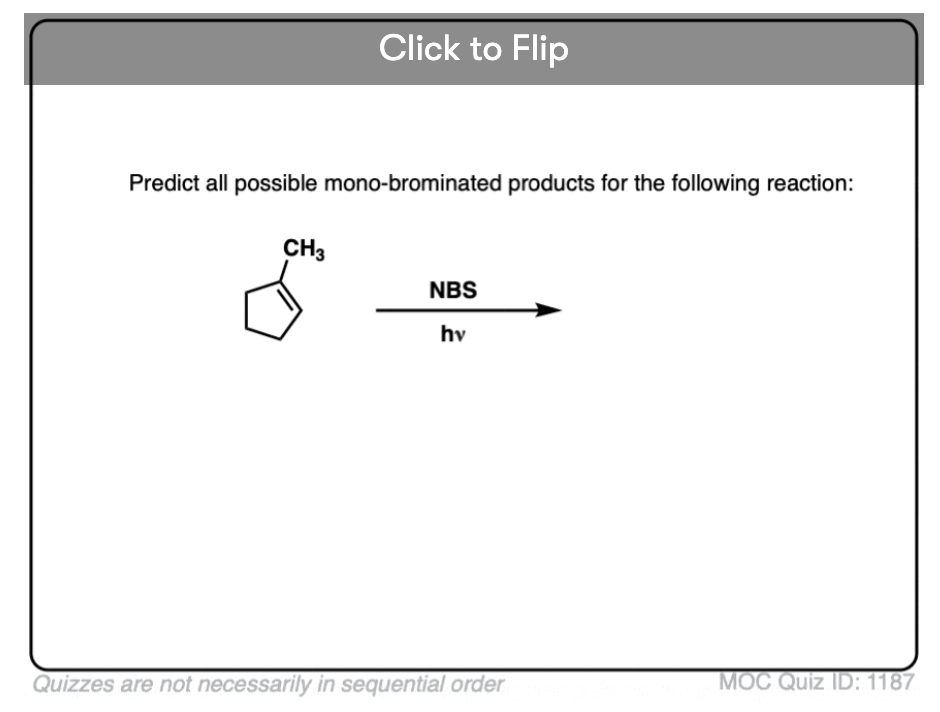
Become a MOC member to see the clickable quiz with answers on the back.

Become a MOC member to see the clickable quiz with answers on the back.
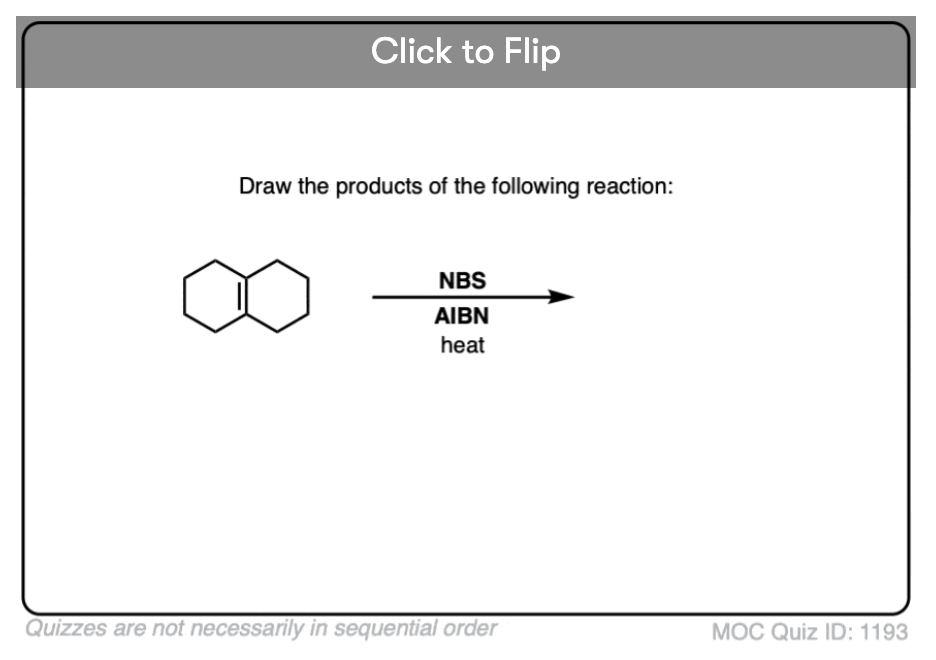
Become a MOC member to see the clickable quiz with answers on the back.
(Advanced) References and Further Reading
Allylic bromination with NBS is sometimes called the Wohl-Ziegler reaction.
- Die Synthese des Cantharidins.
Ziegler, K., Schenck, G., Krockow, E.W., Siebert, A., Wenz, A. and Weber, H. (1942),
Justus Liebigs Ann. Chem., 551: 1-79.
DOI:10.1002/jlac.19425510102
Ziegler’s report on using NBS for allylic bromination, from 1942. - Brominations with N-Bromosuccinimide and Related Compounds. The Wohl-Ziegler Reaction.
Carl. Djerassi
Chemical Reviews 1948 43 (2), 271-317
DOI: 10.1021/cr60135a004
An early but useful review of allylic bromination by Prof. Carl Djerassi (Stanford), who made many important contributions to steroid chemistry. - Laws of Addition and Substitution in Atomic Reactions of Halogens
ADAM, J., GOSSELAIN, P. & GOLDFINGER, P. .
Nature 171, 704–705 (1953).
DOI: 10.1038/171704b0
The “Goldfinger Mechanism” for allylic bromination, which proposed that NBS serves to provide a low concentration of Br2. Earlier proposed mechanisms involved the succinimidyl radical as the chain carrier, which is incorrect. It should be noted that addition of Br• to alkenes *does* occur to some extent, but the reaction is reversible, and if Br2 and HBr concentrations are kept low, any addition product will revert to the starting alkene. - THE HIGH-TEMPERATURE CHLORINATION OF OLEFIN HYDROCARBONS
FREDERICK F. RUST and WILLIAM E. VAUGHAN
The Journal of Organic Chemistry 1940 05 (5), 472-503
DOI: 10.1021/jo01211a002
An early, key observation. Rust and Vaughn found that addition of Cl2 to alkenes is favored at low temperatures, whereas at higher temperatures allylic substitution dominates. - The Ratio of Substitution to Addition in the Reaction of Chlorine with Olefins in Dilute Carbon Tetrachloride Solution
T. D. Stewart, Kenneth Dod, and George Stenmark
Journal of the American Chemical Society 1937 59 (9), 1765-1766
DOI: 10.1021/ja01288a507
An important piece of the puzzle to figuring out the mechanism for allylic halogenation, from 1937. Allylic substitution is favored over addition at lower concentrations of halogen (Cl2). - Mechanisms of Benzylic Bromination
Glen A. Russell, Charles. DeBoer, and Kathleen M. Desmond
Journal of the American Chemical Society 1963 85 (3), 365-366
DOI: 1021/ja00886a040
Benzylic bromination follows the same mechanism as allylic bromination, as this paper explains.NBS (N-Bromosuccinimide) is a convenient reagent for free-radical bromination, and the following papers are mechanistic studies involving NBS: - The Mechanism of Benzylic Bromination with N-Bromosuccinimide
E. Pearson and J. C. Martin
Journal of the American Chemical Society 1963 85 (3), 354-355
DOI: 10.1021/ja00886a029
These papers by Prof J. C. Martin (UIUC) were early in his career, before he did the work that he is most well-known for (studies on ‘hypervalent’ molecules, including the development of the ‘Dess-Martin Periodinane’). - The Identity of the Chain-Carrying Species in Brominations with N-Bromosuccinimide: Selectivity of Substituted N-Bromosuccinimides toward Substituted Toluenes
E. Pearson and J. C. Martin
Journal of the American Chemical Society 1963 85 (20), 3142-3146
DOI: 10.1021/ja00903a021 - N-bromosuccinimide. Mechanisms of allylic bromination and related reactions
H. Incremona and James Cullen Martin
Journal of the American Chemical Society 1970 92 (3), 627-634
DOI: 10.1021/ja00706a034 - Radical Bromination of Cyclohexene in CCl4 by Bromine: Addition versus Substitution
W. McMillen and John B. Grutzner
The Journal of Organic Chemistry 1994 59 (16), 4516-4528
DOI: 10.1021/jo00095a029
This paper describes careful kinetic studies that demonstrate that a low concentration of Br2 (such as that provided by impure NBS) will favor radical substitution over a polar addition reaction. - 4-BROMO-2-HEPTENE
L. Greenwood, M. D. Kellert, and J. Sedlak
Org. Synth. Vol. 38, p.8 (1958).
DOI: 10.115227/orgsyn.038.0008
A reliable procedure for allylic bromination with NBS in Organic Syntheses. - o-XYLYLENE DIBROMIDE
Emily F. M. Stephenson
Org. Synth. Vol. 34, p.100 (1954)
DOI: 10.15227/orgsyn.034.0100
A reliable procedure for benzylic bromination with Br2 in Organic Syntheses. - The evolution of free radical chemistry at Chicago
Frank R. Mayo
Journal of Chemical Education 1986 63 (2), 97
DOI: 1021/ed063p97
For those interested in the history of science, this retrospective by Mayo tells the story of how he and Kharasch discovered the ‘peroxide effect’ and thereby a new area of organic chemistry.
00 General Chemistry Review
01 Bonding, Structure, and Resonance
- How Do We Know Methane (CH4) Is Tetrahedral?
- Hybrid Orbitals and Hybridization
- How To Determine Hybridization: A Shortcut
- Orbital Hybridization And Bond Strengths
- Sigma bonds come in six varieties: Pi bonds come in one
- A Key Skill: How to Calculate Formal Charge
- The Four Intermolecular Forces and How They Affect Boiling Points
- 3 Trends That Affect Boiling Points
- How To Use Electronegativity To Determine Electron Density (and why NOT to trust formal charge)
- Introduction to Resonance
- How To Use Curved Arrows To Interchange Resonance Forms
- Evaluating Resonance Forms (1) - The Rule of Least Charges
- How To Find The Best Resonance Structure By Applying Electronegativity
- Evaluating Resonance Structures With Negative Charges
- Evaluating Resonance Structures With Positive Charge
- Exploring Resonance: Pi-Donation
- Exploring Resonance: Pi-acceptors
- In Summary: Evaluating Resonance Structures
- Drawing Resonance Structures: 3 Common Mistakes To Avoid
- How to apply electronegativity and resonance to understand reactivity
- Bond Hybridization Practice
- Structure and Bonding Practice Quizzes
- Resonance Structures Practice
02 Acid Base Reactions
- Introduction to Acid-Base Reactions
- Acid Base Reactions In Organic Chemistry
- The Stronger The Acid, The Weaker The Conjugate Base
- Walkthrough of Acid-Base Reactions (3) - Acidity Trends
- Five Key Factors That Influence Acidity
- Acid-Base Reactions: Introducing Ka and pKa
- How to Use a pKa Table
- The pKa Table Is Your Friend
- A Handy Rule of Thumb for Acid-Base Reactions
- Acid Base Reactions Are Fast
- pKa Values Span 60 Orders Of Magnitude
- How Protonation and Deprotonation Affect Reactivity
- Acid Base Practice Problems
03 Alkanes and Nomenclature
- Meet the (Most Important) Functional Groups
- Condensed Formulas: Deciphering What the Brackets Mean
- Hidden Hydrogens, Hidden Lone Pairs, Hidden Counterions
- Don't Be Futyl, Learn The Butyls
- Primary, Secondary, Tertiary, Quaternary In Organic Chemistry
- Branching, and Its Affect On Melting and Boiling Points
- The Many, Many Ways of Drawing Butane
- Wedge And Dash Convention For Tetrahedral Carbon
- Common Mistakes in Organic Chemistry: Pentavalent Carbon
- Table of Functional Group Priorities for Nomenclature
- Summary Sheet - Alkane Nomenclature
- Organic Chemistry IUPAC Nomenclature Demystified With A Simple Puzzle Piece Approach
- Boiling Point Quizzes
- Organic Chemistry Nomenclature Quizzes
04 Conformations and Cycloalkanes
- Staggered vs Eclipsed Conformations of Ethane
- Conformational Isomers of Propane
- Newman Projection of Butane (and Gauche Conformation)
- Introduction to Cycloalkanes
- Geometric Isomers In Small Rings: Cis And Trans Cycloalkanes
- Calculation of Ring Strain In Cycloalkanes
- Cycloalkanes - Ring Strain In Cyclopropane And Cyclobutane
- Cyclohexane Conformations
- Cyclohexane Chair Conformation: An Aerial Tour
- How To Draw The Cyclohexane Chair Conformation
- The Cyclohexane Chair Flip
- The Cyclohexane Chair Flip - Energy Diagram
- Substituted Cyclohexanes - Axial vs Equatorial
- Ranking The Bulkiness Of Substituents On Cyclohexanes: "A-Values"
- Cyclohexane Chair Conformation Stability: Which One Is Lower Energy?
- Fused Rings - Cis-Decalin and Trans-Decalin
- Naming Bicyclic Compounds - Fused, Bridged, and Spiro
- Bredt's Rule (And Summary of Cycloalkanes)
- Newman Projection Practice
- Cycloalkanes Practice Problems
05 A Primer On Organic Reactions
- The Most Important Question To Ask When Learning a New Reaction
- Curved Arrows (for reactions)
- Nucleophiles and Electrophiles
- The Three Classes of Nucleophiles
- Nucleophilicity vs. Basicity
- What Makes A Good Nucleophile?
- What Makes A Good Leaving Group?
- 3 Factors That Stabilize Carbocations
- Equilibrium and Energy Relationships
- 7 Factors that stabilize negative charge in organic chemistry
- 7 Factors That Stabilize Positive Charge in Organic Chemistry
- What's a Transition State?
- Hammond's Postulate
- Learning Organic Chemistry Reactions: A Checklist (PDF)
- Introduction to Oxidative Cleavage Reactions
06 Free Radical Reactions
- Free Radical Reactions
- 3 Factors That Stabilize Free Radicals
- Bond Strengths And Radical Stability
- Free Radical Initiation: Why Is "Light" Or "Heat" Required?
- Initiation, Propagation, Termination
- Monochlorination Products Of Propane, Pentane, And Other Alkanes
- Selectivity In Free Radical Reactions
- Selectivity in Free Radical Reactions: Bromination vs. Chlorination
- Halogenation At Tiffany's
- Allylic Bromination
- Bonus Topic: Allylic Rearrangements
- In Summary: Free Radicals
- Synthesis (2) - Reactions of Alkanes
- Free Radicals Practice Quizzes
07 Stereochemistry and Chirality
- Types of Isomers: Constitutional Isomers, Stereoisomers, Enantiomers, and Diastereomers
- How To Draw The Enantiomer Of A Chiral Molecule
- How To Draw A Bond Rotation
- Introduction to Assigning (R) and (S): The Cahn-Ingold-Prelog Rules
- Assigning Cahn-Ingold-Prelog (CIP) Priorities (2) - The Method of Dots
- Enantiomers vs Diastereomers vs The Same? Two Methods For Solving Problems
- Assigning R/S To Newman Projections (And Converting Newman To Line Diagrams)
- How To Determine R and S Configurations On A Fischer Projection
- The Meso Trap
- Optical Rotation, Optical Activity, and Specific Rotation
- Optical Purity and Enantiomeric Excess
- What's a Racemic Mixture?
- Chiral Allenes And Chiral Axes
- Stereochemistry Practice Problems and Quizzes
08 Substitution Reactions
- Nucleophilic Substitution Reactions - Introduction
- Two Types of Nucleophilic Substitution Reactions
- The SN2 Mechanism
- Why the SN2 Reaction Is Powerful
- The SN1 Mechanism
- The Conjugate Acid Is A Better Leaving Group
- Comparing the SN1 and SN2 Reactions
- Polar Protic? Polar Aprotic? Nonpolar? All About Solvents
- Steric Hindrance is Like a Fat Goalie
- Common Blind Spot: Intramolecular Reactions
- Substitution Practice - SN1
- Substitution Practice - SN2
09 Elimination Reactions
- Elimination Reactions (1): Introduction And The Key Pattern
- Elimination Reactions (2): The Zaitsev Rule
- Elimination Reactions Are Favored By Heat
- Two Elimination Reaction Patterns
- The E1 Reaction
- The E2 Mechanism
- E1 vs E2: Comparing the E1 and E2 Reactions
- Antiperiplanar Relationships: The E2 Reaction and Cyclohexane Rings
- Bulky Bases in Elimination Reactions
- Comparing the E1 vs SN1 Reactions
- Elimination (E1) Reactions With Rearrangements
- E1cB - Elimination (Unimolecular) Conjugate Base
- Elimination (E1) Practice Problems And Solutions
- Elimination (E2) Practice Problems and Solutions
10 Rearrangements
11 SN1/SN2/E1/E2 Decision
- Identifying Where Substitution and Elimination Reactions Happen
- Deciding SN1/SN2/E1/E2 (1) - The Substrate
- Deciding SN1/SN2/E1/E2 (2) - The Nucleophile/Base
- SN1 vs E1 and SN2 vs E2 : The Temperature
- Deciding SN1/SN2/E1/E2 - The Solvent
- Wrapup: The Key Factors For Determining SN1/SN2/E1/E2
- Alkyl Halide Reaction Map And Summary
- SN1 SN2 E1 E2 Practice Problems
12 Alkene Reactions
- E and Z Notation For Alkenes (+ Cis/Trans)
- Alkene Stability
- Alkene Addition Reactions: "Regioselectivity" and "Stereoselectivity" (Syn/Anti)
- Stereoselective and Stereospecific Reactions
- Hydrohalogenation of Alkenes and Markovnikov's Rule
- Hydration of Alkenes With Aqueous Acid
- Rearrangements in Alkene Addition Reactions
- Halogenation of Alkenes and Halohydrin Formation
- Oxymercuration Demercuration of Alkenes
- Hydroboration Oxidation of Alkenes
- m-CPBA (meta-chloroperoxybenzoic acid)
- OsO4 (Osmium Tetroxide) for Dihydroxylation of Alkenes
- Palladium on Carbon (Pd/C) for Catalytic Hydrogenation of Alkenes
- Cyclopropanation of Alkenes
- A Fourth Alkene Addition Pattern - Free Radical Addition
- Alkene Reactions: Ozonolysis
- Summary: Three Key Families Of Alkene Reaction Mechanisms
- Synthesis (4) - Alkene Reaction Map, Including Alkyl Halide Reactions
- Alkene Reactions Practice Problems
13 Alkyne Reactions
- Acetylides from Alkynes, And Substitution Reactions of Acetylides
- Partial Reduction of Alkynes With Lindlar's Catalyst
- Partial Reduction of Alkynes With Na/NH3 To Obtain Trans Alkenes
- Alkyne Hydroboration With "R2BH"
- Hydration and Oxymercuration of Alkynes
- Hydrohalogenation of Alkynes
- Alkyne Halogenation: Bromination and Chlorination of Alkynes
- Oxidation of Alkynes With O3 and KMnO4
- Alkenes To Alkynes Via Halogenation And Elimination Reactions
- Alkynes Are A Blank Canvas
- Synthesis (5) - Reactions of Alkynes
- Alkyne Reactions Practice Problems With Answers
14 Alcohols, Epoxides and Ethers
- Alcohols - Nomenclature and Properties
- Alcohols Can Act As Acids Or Bases (And Why It Matters)
- Alcohols - Acidity and Basicity
- The Williamson Ether Synthesis
- Ethers From Alkenes, Tertiary Alkyl Halides and Alkoxymercuration
- Alcohols To Ethers via Acid Catalysis
- Cleavage Of Ethers With Acid
- Epoxides - The Outlier Of The Ether Family
- Opening of Epoxides With Acid
- Epoxide Ring Opening With Base
- Making Alkyl Halides From Alcohols
- Tosylates And Mesylates
- PBr3 and SOCl2
- Elimination Reactions of Alcohols
- Elimination of Alcohols To Alkenes With POCl3
- Alcohol Oxidation: "Strong" and "Weak" Oxidants
- Demystifying The Mechanisms of Alcohol Oxidations
- Protecting Groups For Alcohols
- Thiols And Thioethers
- Calculating the oxidation state of a carbon
- Oxidation and Reduction in Organic Chemistry
- Oxidation Ladders
- SOCl2 Mechanism For Alcohols To Alkyl Halides: SN2 versus SNi
- Alcohol Reactions Roadmap (PDF)
- Alcohol Reaction Practice Problems
- Epoxide Reaction Quizzes
- Oxidation and Reduction Practice Quizzes
15 Organometallics
- What's An Organometallic?
- Formation of Grignard and Organolithium Reagents
- Organometallics Are Strong Bases
- Reactions of Grignard Reagents
- Protecting Groups In Grignard Reactions
- Synthesis Problems Involving Grignard Reagents
- Grignard Reactions And Synthesis (2)
- Organocuprates (Gilman Reagents): How They're Made
- Gilman Reagents (Organocuprates): What They're Used For
- The Heck, Suzuki, and Olefin Metathesis Reactions (And Why They Don't Belong In Most Introductory Organic Chemistry Courses)
- Reaction Map: Reactions of Organometallics
- Grignard Practice Problems
16 Spectroscopy
- Degrees of Unsaturation (or IHD, Index of Hydrogen Deficiency)
- Conjugation And Color (+ How Bleach Works)
- Introduction To UV-Vis Spectroscopy
- UV-Vis Spectroscopy: Absorbance of Carbonyls
- UV-Vis Spectroscopy: Practice Questions
- Bond Vibrations, Infrared Spectroscopy, and the "Ball and Spring" Model
- Infrared Spectroscopy: A Quick Primer On Interpreting Spectra
- IR Spectroscopy: 4 Practice Problems
- 1H NMR: How Many Signals?
- Homotopic, Enantiotopic, Diastereotopic
- Diastereotopic Protons in 1H NMR Spectroscopy: Examples
- 13-C NMR - How Many Signals
- Liquid Gold: Pheromones In Doe Urine
- Natural Product Isolation (1) - Extraction
- Natural Product Isolation (2) - Purification Techniques, An Overview
- Structure Determination Case Study: Deer Tarsal Gland Pheromone
17 Dienes and MO Theory
- What To Expect In Organic Chemistry 2
- Are these molecules conjugated?
- Conjugation And Resonance In Organic Chemistry
- Bonding And Antibonding Pi Orbitals
- Molecular Orbitals of The Allyl Cation, Allyl Radical, and Allyl Anion
- Pi Molecular Orbitals of Butadiene
- Reactions of Dienes: 1,2 and 1,4 Addition
- Thermodynamic and Kinetic Products
- More On 1,2 and 1,4 Additions To Dienes
- s-cis and s-trans
- The Diels-Alder Reaction
- Cyclic Dienes and Dienophiles in the Diels-Alder Reaction
- Stereochemistry of the Diels-Alder Reaction
- Exo vs Endo Products In The Diels Alder: How To Tell Them Apart
- HOMO and LUMO In the Diels Alder Reaction
- Why Are Endo vs Exo Products Favored in the Diels-Alder Reaction?
- Diels-Alder Reaction: Kinetic and Thermodynamic Control
- The Retro Diels-Alder Reaction
- The Intramolecular Diels Alder Reaction
- Regiochemistry In The Diels-Alder Reaction
- The Cope and Claisen Rearrangements
- Electrocyclic Reactions
- Electrocyclic Ring Opening And Closure (2) - Six (or Eight) Pi Electrons
- Diels Alder Practice Problems
- Molecular Orbital Theory Practice
18 Aromaticity
- Introduction To Aromaticity
- Rules For Aromaticity
- Huckel's Rule: What Does 4n+2 Mean?
- Aromatic, Non-Aromatic, or Antiaromatic? Some Practice Problems
- Antiaromatic Compounds and Antiaromaticity
- The Pi Molecular Orbitals of Benzene
- The Pi Molecular Orbitals of Cyclobutadiene
- Frost Circles
- Aromaticity Practice Quizzes
19 Reactions of Aromatic Molecules
- Electrophilic Aromatic Substitution: Introduction
- Activating and Deactivating Groups In Electrophilic Aromatic Substitution
- Electrophilic Aromatic Substitution - The Mechanism
- Ortho-, Para- and Meta- Directors in Electrophilic Aromatic Substitution
- Understanding Ortho, Para, and Meta Directors
- Why are halogens ortho- para- directors?
- Disubstituted Benzenes: The Strongest Electron-Donor "Wins"
- Electrophilic Aromatic Substitutions (1) - Halogenation of Benzene
- Electrophilic Aromatic Substitutions (2) - Nitration and Sulfonation
- EAS Reactions (3) - Friedel-Crafts Acylation and Friedel-Crafts Alkylation
- Intramolecular Friedel-Crafts Reactions
- Nucleophilic Aromatic Substitution (NAS)
- Nucleophilic Aromatic Substitution (2) - The Benzyne Mechanism
- Reactions on the "Benzylic" Carbon: Bromination And Oxidation
- The Wolff-Kishner, Clemmensen, And Other Carbonyl Reductions
- More Reactions on the Aromatic Sidechain: Reduction of Nitro Groups and the Baeyer Villiger
- Aromatic Synthesis (1) - "Order Of Operations"
- Synthesis of Benzene Derivatives (2) - Polarity Reversal
- Aromatic Synthesis (3) - Sulfonyl Blocking Groups
- Birch Reduction
- Synthesis (7): Reaction Map of Benzene and Related Aromatic Compounds
- Aromatic Reactions and Synthesis Practice
- Electrophilic Aromatic Substitution Practice Problems
20 Aldehydes and Ketones
- What's The Alpha Carbon In Carbonyl Compounds?
- Nucleophilic Addition To Carbonyls
- Aldehydes and Ketones: 14 Reactions With The Same Mechanism
- Sodium Borohydride (NaBH4) Reduction of Aldehydes and Ketones
- Grignard Reagents For Addition To Aldehydes and Ketones
- Wittig Reaction
- Hydrates, Hemiacetals, and Acetals
- Imines - Properties, Formation, Reactions, and Mechanisms
- All About Enamines
- Breaking Down Carbonyl Reaction Mechanisms: Reactions of Anionic Nucleophiles (Part 2)
- Aldehydes Ketones Reaction Practice
21 Carboxylic Acid Derivatives
- Nucleophilic Acyl Substitution (With Negatively Charged Nucleophiles)
- Addition-Elimination Mechanisms With Neutral Nucleophiles (Including Acid Catalysis)
- Basic Hydrolysis of Esters - Saponification
- Transesterification
- Proton Transfer
- Fischer Esterification - Carboxylic Acid to Ester Under Acidic Conditions
- Lithium Aluminum Hydride (LiAlH4) For Reduction of Carboxylic Acid Derivatives
- LiAlH[Ot-Bu]3 For The Reduction of Acid Halides To Aldehydes
- Di-isobutyl Aluminum Hydride (DIBAL) For The Partial Reduction of Esters and Nitriles
- Amide Hydrolysis
- Thionyl Chloride (SOCl2) And Conversion of Carboxylic Acids to Acid Halides
- Diazomethane (CH2N2)
- Carbonyl Chemistry: Learn Six Mechanisms For the Price Of One
- Making Music With Mechanisms (PADPED)
- Carboxylic Acid Derivatives Practice Questions
22 Enols and Enolates
- Keto-Enol Tautomerism
- Enolates - Formation, Stability, and Simple Reactions
- Kinetic Versus Thermodynamic Enolates
- Aldol Addition and Condensation Reactions
- Reactions of Enols - Acid-Catalyzed Aldol, Halogenation, and Mannich Reactions
- Claisen Condensation and Dieckmann Condensation
- Decarboxylation
- The Malonic Ester and Acetoacetic Ester Synthesis
- The Michael Addition Reaction and Conjugate Addition
- The Robinson Annulation
- Haloform Reaction
- The Hell–Volhard–Zelinsky Reaction
- Enols and Enolates Practice Quizzes
23 Amines
- The Amide Functional Group: Properties, Synthesis, and Nomenclature
- Basicity of Amines And pKaH
- 5 Key Basicity Trends of Amines
- The Mesomeric Effect And Aromatic Amines
- Nucleophilicity of Amines
- Alkylation of Amines (Sucks!)
- Reductive Amination
- The Gabriel Synthesis
- Some Reactions of Azides
- The Hofmann Elimination
- The Hofmann and Curtius Rearrangements
- The Cope Elimination
- Protecting Groups for Amines - Carbamates
- The Strecker Synthesis of Amino Acids
- Introduction to Peptide Synthesis
- Reactions of Diazonium Salts: Sandmeyer and Related Reactions
- Amine Practice Questions
24 Carbohydrates
- D and L Notation For Sugars
- Pyranoses and Furanoses: Ring-Chain Tautomerism In Sugars
- What is Mutarotation?
- Reducing Sugars
- The Big Damn Post Of Carbohydrate-Related Chemistry Definitions
- The Haworth Projection
- Converting a Fischer Projection To A Haworth (And Vice Versa)
- Reactions of Sugars: Glycosylation and Protection
- The Ruff Degradation and Kiliani-Fischer Synthesis
- Isoelectric Points of Amino Acids (and How To Calculate Them)
- Carbohydrates Practice
- Amino Acid Quizzes
25 Fun and Miscellaneous
- A Gallery of Some Interesting Molecules From Nature
- Screw Organic Chemistry, I'm Just Going To Write About Cats
- On Cats, Part 1: Conformations and Configurations
- On Cats, Part 2: Cat Line Diagrams
- On Cats, Part 4: Enantiocats
- On Cats, Part 6: Stereocenters
- Organic Chemistry Is Shit
- The Organic Chemistry Behind "The Pill"
- Maybe they should call them, "Formal Wins" ?
- Why Do Organic Chemists Use Kilocalories?
- The Principle of Least Effort
- Organic Chemistry GIFS - Resonance Forms
- Reproducibility In Organic Chemistry
- What Holds The Nucleus Together?
- How Reactions Are Like Music
- Organic Chemistry and the New MCAT
26 Organic Chemistry Tips and Tricks
- Common Mistakes: Formal Charges Can Mislead
- Partial Charges Give Clues About Electron Flow
- Draw The Ugly Version First
- Organic Chemistry Study Tips: Learn the Trends
- The 8 Types of Arrows In Organic Chemistry, Explained
- Top 10 Skills To Master Before An Organic Chemistry 2 Final
- Common Mistakes with Carbonyls: Carboxylic Acids... Are Acids!
- Planning Organic Synthesis With "Reaction Maps"
- Alkene Addition Pattern #1: The "Carbocation Pathway"
- Alkene Addition Pattern #2: The "Three-Membered Ring" Pathway
- Alkene Addition Pattern #3: The "Concerted" Pathway
- Number Your Carbons!
- The 4 Major Classes of Reactions in Org 1
- How (and why) electrons flow
- Grossman's Rule
- Three Exam Tips
- A 3-Step Method For Thinking Through Synthesis Problems
- Putting It Together
- Putting Diels-Alder Products in Perspective
- The Ups and Downs of Cyclohexanes
- The Most Annoying Exceptions in Org 1 (Part 1)
- The Most Annoying Exceptions in Org 1 (Part 2)
- The Marriage May Be Bad, But the Divorce Still Costs Money
- 9 Nomenclature Conventions To Know
- Nucleophile attacks Electrophile
27 Case Studies of Successful O-Chem Students
- Success Stories: How Corina Got The The "Hard" Professor - And Got An A+ Anyway
- How Helena Aced Organic Chemistry
- From a "Drop" To B+ in Org 2 – How A Hard Working Student Turned It Around
- How Serge Aced Organic Chemistry
- Success Stories: How Zach Aced Organic Chemistry 1
- Success Stories: How Kari Went From C– to B+
- How Esther Bounced Back From a "C" To Get A's In Organic Chemistry 1 And 2
- How Tyrell Got The Highest Grade In Her Organic Chemistry Course
- This Is Why Students Use Flashcards
- Success Stories: How Stu Aced Organic Chemistry
- How John Pulled Up His Organic Chemistry Exam Grades
- Success Stories: How Nathan Aced Organic Chemistry (Without It Taking Over His Life)
- How Chris Aced Org 1 and Org 2
- Interview: How Jay Got an A+ In Organic Chemistry
- How to Do Well in Organic Chemistry: One Student's Advice
- "America's Top TA" Shares His Secrets For Teaching O-Chem
- "Organic Chemistry Is Like..." - A Few Metaphors
- How To Do Well In Organic Chemistry: Advice From A Tutor
- Guest post: "I went from being afraid of tests to actually looking forward to them".
i am doing bromination reaction with use of dibromo dimethyl hydantoin 0.54 mole but i found dibromo impurity level well above to 10.5%,so how i can reduce di bromo impurity to below 3.0%
Why can’t you use Br2 and peroxides for benzylic cases?
You can, as in this procedure: http://www.orgsyn.org/demo.aspx?prep=CV4P0984
If the NBS you are using happens to be significantly contaminated with HBr/Br2, is it then possible to add more than one bromine?
It is standard procedure in many reactions to add a slight molar excess (e.g. 10%) of a reagent just to ensure completion of the reaction. I have not seen analyses of “bad” NBS to quantify just how high the Br2 content can get, but I would not expect it to be more than 10%.
So my short answer is no, not to any significant extent that it would impair the yield by more than 10%.
If there *is* a lot of Br2 present, two things could happen. First, if the impure NBS is just added to solution and dissolved, without adding alkene first, the Br2 that has been liberated can re-combine with succinimide (this is, after all, how NBS is formed).
If a relatively high concentration of Br2 persists, then what is more likely is that one would start to see dibromination of the alkene (i.e. addition of Br2) across the double bond, since bromination tends to be 3rd order overall, and low concentrations of Br2 avoid this side reaction.
In this case, then there would again a lower yield of the desired product, but not double addition of bromine.
If a large excess of NBS is added, then yes, it could start to be an issue.
What will be the product when 3- methylene cyclohexene react with HBr? Explain
You will need to identify what will be the kinetic and thermodynamic product. https://www.masterorganicchemistry.com/2017/03/22/reactions-of-dienes-12-and-14-addition/
I’m a little bit confused. It seems like your explanation to achieve a low concentration of Br2 to avoid dibromination is to react a trace amount of HBr with NBS to get a small amount of Br2, and then react Br2 in the presence of a solvent and with light to end up with an allylic brominated product. Why can’t we just start with a small amount of Br2 and react that with light in the first place? Why do we have to start with HBr and NBS?
If On product 3 bromo cyclo pentene further addition of Br2, is done then what will be the product ?
Bromination is possible ??
Yes, if you added Br2 to 3-bromocyclopentene, you would brominate the double bond.
Hi James
I just wanted to know why we are using CCl4 as a solvent?
Nice and high boiling. If it takes heat to initiate the reaction it’s useful to choose a solvent which has a relatively high boiling point. There’s also no C-H bonds which can potentially react with free radicals.
Hi James
I’ve a question about para ethyltoluene,(4-ethyltoluene) what will happen when it reacts with HBR, i can’t figure out where the bromation will take place,
what happens if chlorobenzene reacts with KI ? is there any reaction? if yes where does it take place? i’ve an orgnic examen ,and i really don’t know how to handle those kinds of reactions.
Thanks
Bromination will not happen using HBr as a reagent. In that case all that will happen is that you will (transiently) protonate the ring.
Chlorobenzene plus KI under (extraordinarily) forcing conditions MAY yield iodobenzene via nucleophilic aromatic substitution, but there are much better ways to do it.
how can one selectively brominate one benzylic site out of two different sites……say if i want to slectively brominate the benzylic -CH2- group of p-ethyltoluene instead of the benzylic -CH3 group?
The secondary radical should be more stable, so you should at least get some selectivity for that position.
If you were to have a molecule with a t-butyl substituent and a methyl substituent, with which group would the Br radical be more likely to react with?
The particular molecule that brought up this question is 1-methyl-3-tert-butylbenzene.
Methyl. There’s no benzylic C–H hydrogen for the bromine radical to remove from the t-butyl.
Hi james
why wouldn’t Br• attack on the vinylic carbon instead of allylic carbon just like it does in the peroxide effect ?
And for the reason u give why would be it not applicable in peroxide effect?
Gamma should be nu.
Yes, fixed, thank you!
Hi James,
Would the same reasoning for allylic bromination apply to allylic chlorination as well?
Yes.
Hi,
Can I use DCM (dichlormethan) as a solvent instead of PhCl? Radical reactions are often not very selective. Why can brominate anyway selective just at the benzylposition and not somewhere else?
Many thinks
Usually you want a solvent that has a reasonably high boiling point since the initiation step requires heat. Dichloromethane is pretty low boiling. You could go for dichloroethane instead. (83 C° versus 40 C°)
Hi James–
As I understood, allylic means the molecule two away from the double bond, not directly attached, and vinylic means it is attached to the double bond. Therefore wouldn’t the radical on the 3rd carbon of 1-propene be vinylic?
A vinylic radical would be directly attached to the double bond – i.e. sp2 hybridized . For example a radical on the 1 or 2 carbon of 1-propene would be vinylic. The adjacent carbon (carbon 3) is allylic. If there was a 4th carbon that position would be called, “homoallylic”.
Dear james,
Can you please tell me what will be the product when 3 methyl cyclohexene reacts with NBS/br2.
Thank you
At least two different allylic bromination products are possible.
James,
Is there any other solvent except of CCl4 that can be used in benzylic halogenations?
Many thanks
I’d try chloroform or 1,2-dichloroethane.
wouldn’t Br• attack on the vinylic carbon just like it does in the peroxide effect and the resulting radical would further start a chain reaction by attacking on Br2
The vinyl C-H bonds have a bond dissociation energy of around 111 kcal/mol and the allyl C-H bonds have a bond dissociation energy of around 90 kcal/mol so it’s easier to break the allyl C-H bond and form the radical there.
Hey James,
Would I be correct in assuming that unless strict conditions are employed such as 1 equivalent of NBS, a second bromine addition will take place? Or will the EWG nature of the first bromide affect a second addition?
Also the physics student in me would like to point out that light is represented by h(nu) not h(gamma). Quite trivial I know.
Bromonium ion formation is reversible so as long as no strong nucleophiles are present to open it, it’s possible to get away with an excess of NBS. What often happens is that you need to keep adding the radical initiator (like AIBN or peroxides) over time if the reaction stops.
Thanks for the correction!
James,
In the allylic bromination, after the initiation step, bromine radicals are formed. They have one electron less than their requirement and so they want to pick one electron. Then why don’t they cleave the pi bond, which has loosely bound electron, and take it from there?
What you’re describing is addition of bromine radical to a pi bond, which is what happens when you treat an alkene with peroxides and HBr. In that reaction, once Br• adds to the pi bond, you obtain a radical on a carbon. If plenty of HBr is present, then the radical attacks the H of HBr and the cycle continues.
However in the case of allylic bromination, that reaction is (ideally) a cul-de-sac. Once Br• radical addds to the double bond, forming that carbon-based radical, there is (ideally) nothing for it to react with since we’re not adding HBr and we’re keeping the concentration of Br2 low. Therefore the addition will revert back to the double bond and Br radical, and eventually the Br• will abstract a hydrogen from the allylic position.
The same question came up in class today, and a quick bond energy calculation suggests the addition of Br2 across the double bond might be more favorable. The propagation step of allylic H abstraction is slightly endothermic, while the propagation step in “competing” radical addition to the C=C pi bond is slightly exothermic.
This had me confused for a while, but a trip to my old graduate physical organic text (Lowry & Richardson, 1981, pp. 717-726) suggested that the Arrhenius collision orientation factor for abstraction is much more favorable than that for pi-addition, even though the activation energy is a bit less. The net result is a difference in rate constants of a factor of ~5 at 300 K. At the typical reaction temperature (refluxing CCl4, ~350 K) the difference is about a factor of 13.
Thanks Dave. Does L&R point to the original literature reference?